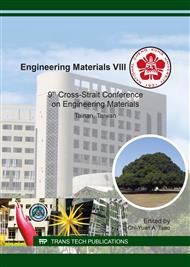p.11
p.16
p.24
p.32
p.38
p.43
p.50
p.55
p.59
Influence of Sever Plastic Deformation on the Consolidation Behavior of Al-SiC Mixed Powder
Abstract:
Abstract: Oxidized and non-oxidized SiC particulates were mixed with Al powder respectively and the two kinds of mixed powders were consolidated at 250°C by equal channel angular pressing and torsion (ECAP-T), which belongs to severe plastic deformation. The interfacial bondings of as-consolidated composites were characterized by SEM images, corrosion morphology and fracture morphology. The results show that after severe plastic deformation, the interfacial bonding between non-oxidized SiC and Al is a kind of mechanical bonding and the consolidation is not firm enough so that the composite has a weak corrosion resistance and its tensile sample has a brittle fracture. However, the composite containing oxidized SiC has a dense microstructure, high corrosion resistance, ductile fracture due to the metallurgical interface.
Info:
Periodical:
Pages:
38-42
Citation:
Online since:
March 2017
Authors:
Price:
Сopyright:
© 2017 Trans Tech Publications Ltd. All Rights Reserved
Share:
Citation:


